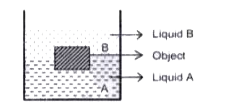When an object is made to float in two different liquids of densities d1 and d2, the length of the object seen above the liquid surface are 4 cm and 5 cm respectively. Which of the following is the correct alternative?
d1>d2
d1<d2
d1=d2
None of these
The correct Answer is:B
To solve the problem, we need to analyze the situation where an object is floating in two different liquids with different densities. The length of the object above the liquid surface gives us information about the relationship between the density of the object and the densities of the liquids.
1. Understanding Floating Objects: When an object floats in a liquid, it displaces a volume of liquid equal to the weight of the object. The part of the object submerged in the liquid is determined by the densities of the object and the liquid.
2. Given Information:
- Length of the object above liquid 1 (density d1) = 4 cm
- Length of the object above liquid 2 (density d2) = 5 cm
3. Calculating Submerged Length:
- Let the total length of the object be L.
- The submerged length in liquid 1 = L−4 cm
- The submerged length in liquid 2 = L−5 cm
4. Using Archimedes' Principle: According to Archimedes' principle, the weight of the liquid displaced is equal to the weight of the object. Therefore, we can set up the following equations based on the densities:
- For liquid 1:
d1×(L−4)=Weight of the object
- For liquid 2:
d2×(L−5)=Weight of the object
5. Equating the Two Expressions:
Since both expressions equal the weight of the object, we can set them equal to each other:
d1×(L−4)=d2×(L−5)
6. Rearranging the Equation:
Rearranging gives us:
d1×L−4d1=d2×L−5d2
d1×L−d2×L=4d1−5d2
(d1−d2)×L=4d1−5d2
7. Analyzing the Result:
- If d1>d2, then 4d1−5d2>0 implies L>0 which is true.
- If d1<d2, then 4d1−5d2<0 implies L<0 which is not possible.
Therefore, we conclude that d1<d2.
Final Conclusion:
The correct alternative is that d1 is smaller than d2.
---
- Length of the object above liquid 1 (density d1) = 4 cm
- Length of the object above liquid 2 (density d2) = 5 cm
- Let the total length of the object be L.
- The submerged length in liquid 1 = L−4 cm
- The submerged length in liquid 2 = L−5 cm
- For liquid 1:
d1×(L−4)=Weight of the object
- For liquid 2:
d2×(L−5)=Weight of the object
Since both expressions equal the weight of the object, we can set them equal to each other:
d1×(L−4)=d2×(L−5)
Rearranging gives us:
d1×L−4d1=d2×L−5d2
d1×L−d2×L=4d1−5d2
(d1−d2)×L=4d1−5d2
- If d1>d2, then 4d1−5d2>0 implies L>0 which is true.
- If d1<d2, then 4d1−5d2<0 implies L<0 which is not possible.
The correct alternative is that d1 is smaller than d2.
Topper's Solved these Questions
- NSO QUESTION PAPER 2019-20 SET BBOOK - SCIENCE OLYMPIAD FOUNDATION CHAPTER - NSO QUESTION PAPER 2019-20 SET BEXERCISE - ACHIEVERS SECTION
2 Videos
- NSO QUESTION PAPER 2019-20 SET ABOOK - SCIENCE OLYMPIAD FOUNDATION CHAPTER - NSO QUESTION PAPER 2019-20 SET AEXERCISE - ACHIEVERS SECTION
2 Videos
- NSO QUESTION PAPER 2020-21 SET ABOOK - SCIENCE OLYMPIAD FOUNDATION CHAPTER - NSO QUESTION PAPER 2020-21 SET AEXERCISE - SCIENCE
18 Videos
Similar Questions
A body is placed over the surfaces of two liquids of densities d1andd2(d1>d2) separately. If the density of the object is less than both the liquids in which liquids the body immerses more?
View SolutionAn object is made to float in two immiscible liquids as shown in figure. Compare the densities of two liquids A and B and the object.

View Solution
Knowledge Check
When an object is made to float in two different liquids of density d1andd2, the lengths of the object seen above the liquid surface are l1andl2, respectively.
Which of the following is the correct alternative ?Ad2>d1,ifl1>l2Bd1>d2,ifl2>l1Cd1<d2,ifl2>l1Dd2<d1,ifl2>l1In displacement method, the lengths of images in the two positions of the lens betwent the object and the screen are 9 cm and 4 cm respectively. The length of the object must be
A6.25 cmB1.5 cmC6 cmD36 cmAn object is put on by one in three liquids having different densities. The object floats with 1/9, 2/11 and 3/7 parts of their volumes outsides the liquid surface in liquids of densities d1, d2 and d3 respectively. Which of the following statements is correct?
Ad1>d2>d3Bd1>d2<d3Cd1<d2>d3Dd1<d2<d3
An object weights m1 in a liquid of density d1 and that in liquid of density d2 is m2. The density of the object is
View SolutionWhen a body of density d1 and volume V is floating in a liquid of density d2
View SolutionSimilar objects are dropped into two different liquids A and B. The displacement of the objects in A and B in 5s is S1 and S2, respectively. If density of the liquid A is greater than the density of the liquid B, which among the following relation is correct ?
View SolutionAn object is put one by one in three liquids having different densities. The object floats with 19,212and37 parts of their volumes outside the liquid surface in liquids of densities d1,d2andd3, respectively. Which of the following statement is correct ?
View SolutionAn object of mass m is floating in a liquid of density σ. If the object is made up of density ρ, then appare weight of the object in the liquid is
View Solution
